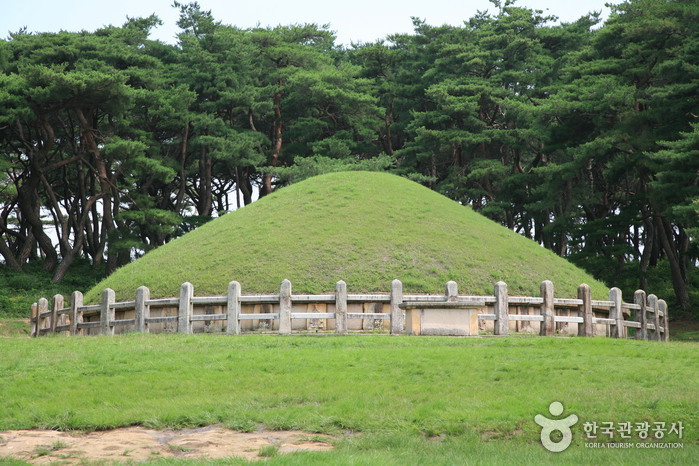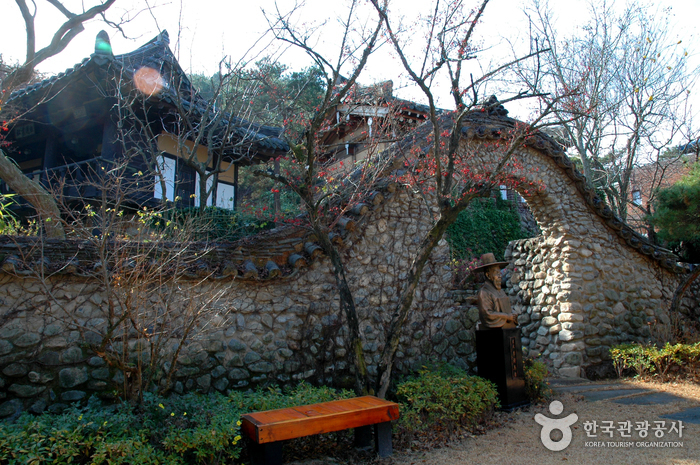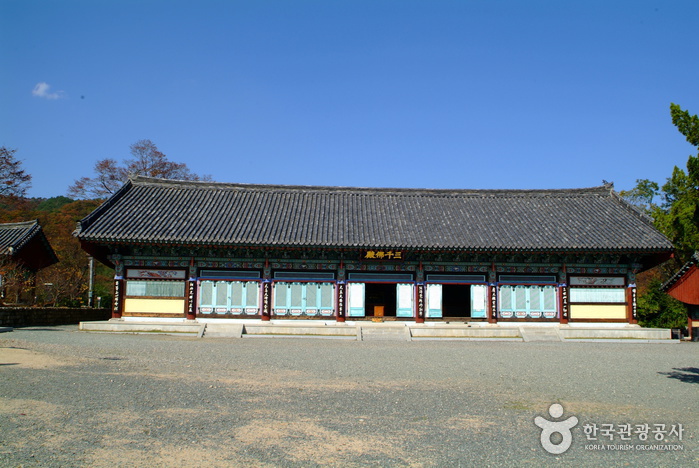Bulguksa Hanok Farm Stay [Korea Quality] / 불국사한옥팜스테이 [한국관광 품질인증]
12.1 Km 1 2022-04-06
5-52, Jinti-gil, Gyeongju-si, Gyeongsangbuk-do
+82-10-5489-1742
Bulguksa Hanok Farm Stay is an accommodation that offers many programs located right below Bulguksa Temple in Jinhyeon-dong, Gyeongju-si, Gyeongsangbuk-do. There is a total of four guest rooms. Every guest room has a bathroom and a kitchen inside. You can also cook in the rooms as they are equipped with cooking appliances such as a rice cooker, microwave, and electric stove. Ouga is a double-story unit, and the guest rooms on the first floor and the second floor are rented separately. On the first floor, there is an ondol room big enough for four people, and the ondol room on the second floor is big enough for three people and has a nice view. Both rooms have a terrace where guests can enjoy a barbecue grill. Bogyeonga also has two guest rooms that are rented separately. All of the rooms are ondol type rooms. In the Bogyeonga building, only room 1 has a double-story structure. Guests staying in the Bogyeonga building can have a barbecue grill in the terrace. A well-maintained garden is surrounding the hanok building, and there is also a 1,000-square-meter foot volleyball court in the lawn. A unique benefit of staying in Bulguksa Hanok Farm Stay is that you can participate in farming programs. You can pick apples from 400 apple trees on the farm. You can also participate in various programs themed on the food crops grown in the farm, including persimmon, quince, blueberry, lettuce, and tomato. Nearby tourist attractions include Bulguksa Temple, Seokguram Grotto, Bomun Tourist Complex, Donggung Palace and Wolji Pond, Cheomseongdae, and Woljeonggyo Bridge in Gyeongju. California Beach (water park) is also closeby.
Gyeongju Seokguram Grotto [UNESCO World Heritage] (경주 석굴암 [유네스코 세계문화유산])
13.2 Km 137981 2023-08-24
873-243, Bulguk-ro, Gyeongju-si, Gyeongsangbuk-do
+82-54-746-9933
Seokguram Grotto was constructed by Kim Dae-Seong during the reign of King Gyeong-Deok (742-765) of the Silla Kingdom. Located 3 kilometers away by hiking trail and 9 kilometers by car from Bulguksa Temple, the grotto was designed very harmoniously with the seated Buddha facing the East Sea. It is a valuable cultural heritage that is preserved and registered as a UNESCO World Heritage on December 6, 1995.
Tomb of King Wonseong (경주 원성왕릉)
13.2 Km 12652 2020-04-04
139, Singyeipsil-gil, Gyeongju-si, Gyeongsangbuk-do
+82-54-779-6100
The tomb of the King Wonseong, 38th king of the Silla Kingdom (785-798) in Oedong-eup, Wolseong-gun, Gyeongju is Historic Site No. 26. The tomb is 21.9m in diameter and 7.7m high and is encircled by a stone fence decorated with twelve oriental zodiac images. The area is also home to a number of stone monuments that stand facing each other: Hwapyoseok (marking the border of the tomb), Muninseok (civil servant statue), Muinseok (military officer image statue) and Dolsaja (a stone lion that protects the tomb). Muinseok in particular is a favorite among visitors because of its exotic appearance. The statue is sometimes compared to a strong and charismatic person of Arabic or Persian descendant, much like the merchants who came to Silla in ancient times.
Gwaereung is styled after tombs of the Tang dynasty, but still retains all the characteristics typical of Silla tombs; namely, the stones around the tomb, the 12 oriental zodiac figures, the protective walls, and the decorative stonework.
The Oriental Medicine Resort: Chorakdang (한방테마파크 초락당)
14.9 Km 17091 2021-02-10
44-34, Gyemyeong-ro, Ulju-gun, Ulsan
+82-52-264-8001
Opened in 2001, Chorakdang is a health resort that specializes in Oriental medicine treatments. The resort offers the perfect setting for rest, relaxation, and medical treatments. The traditional hanok buildings and natural surroundings intensify the health benefits of the resort.
Tohamsan National Recreational Forest (토함산자연휴양림)
16.2 Km 37338 2021-04-08
1208-45, Bulguk-ro, Gyeongju-si, Gyeongsangbuk-do
+82-54-750-8700
Tohamsan National Recreational Forest, located in Gyeongju, is in close vicinity of major attractions such as Bulguksa Temple and Seokguram Grotto. Visitors can enjoy the culture as well as relaxing in a peaceful nature.
Oeosa Temple (오어사(포항))
16.5 Km 38520 2023-01-25
1 , Oeo-ro, Nam-gu, Pohang-si, Gyeongsangbuk-do
+82-54-292-2083
Oeosa Temple in Unjesan Mountain is a place where the deep scent of Buddha can be felt with a lake that looks like a dragon wrapped around it and the strangely-shaped cliffs which harmonizes like an oriental painting. Oeosa Temple is a sacred place where the four great patriarchs of Silla were born. This temple was built during the reign of King Jinpyeong (579-632), the 26th ruler of Silla. It was originally called Hangsasa Temple, but when Great Master Wonhyo and Zen Master Hyegong practiced religious asceticism here, a contest was held to revive the fish in the stream with religious power. However, one of them did not survive, and the other did and swam vigorously.
So each argued that he himself saved the fish, so they called it Oeosa Temple by writing the characters 'O' and 'Eo.' Daeungjeon Hall has a hip-and-gable roof with three bays in the front and two in the side. It was rebuilt in the 17th year of King Yeongjo of the Joseon dynasty (1741). Around the temple, the beautiful natural scenery of Unjesan Mountain and the blue water of Oeoji are spectacular. Jajangam Hermitage can be seen on the rocky cliff, and Wonhyoam Hermitage can be seen to the west of Oeosa Temple. Daeungjeon Hall (Gyeongbuk cultural heritage) has a national treasure bell, Buddhist monk Wonhyo's hat, and many other relics.
Girimsa Temple (기림사)
16.8 Km 15060 2022-12-29
437-17, Girim-ro, Gyeongju-si, Gyeongsangbuk-do
+82-54-744-2292
Girimsa Temple is located in Hamwolsan Mountain in Yangbuk-myeon, Gyeongju. The temple was built in the Silla Era and, with 16 buildings, is the second largest temple after Bulguksa.
Legend has it that the temple was originally built by the Venerable Gwang-yu, a sage from India, in the early part of the Silla Kingdom. The temple was reportedly called Imjeongsa at first, but was later changed to Girimsa after undergoing expansive renovations by Monk Wonhyo. It is still unclear exactly what year the temple was built in.
Girimsa is divided into two main areas. The first is the area around Daejeokgwangjeon Hall where the statue of Birojanabul is enshrined. The second is the area around the majestic 500-year-old bo tree (a kind of large fig tree) that is home to a wooden pagoda, the Seongbo Museum, Samsingak, Mangbujeon, and Gwaneumjeon halls. Daejeokgwangjeon Hall was first built during Queen Seondeok's reign, and was rebuilt six times since its original construction. Its simple but majestic architecture is characterized by baeheullim (aka, entasis columns) and a Dapoyangsik (Dapo-style) single-tiered gabled roof.
Girimsa is famous for Ojongsu, water that is said to have five different tastes. It consists of gamrosu, which is best for making tea; hwajeongsu, which supposedly gives comfort to the drinker; janggunsu, which makes the body stronger; myeongansu, which gives clear vision; and otaksu, which is said to sparkle so brightly that it attracts all the birds of the air. During Japanese colonial rule, the source of janggunsu, literally meaning ‘water of a general,’ was reportedly blocked off by Japanese soldiers, who were afraid the water would give the Korean people the strength to overthrow them. Except for janggunsu, water still continues to flow from each source.
On the way to Girimsa temple is Golgulsa Temple, well known for its 12 grottos. Golgulsa was originally a hermitage of Girimsa. After becoming an independent institution, it became the center of Seonmudo practice in Korea. The temple aims to promote the art of seonmudo on a national and international level.
Gyeongju Yangdong Village [UNESCO World Heritage] (경주 양동마을 [유네스코 세계문화유산])
17.3 Km 87901 2022-11-08
134 , Yangdongmaeul-gil, Gyeongju-si, Gyeongsangbuk-do
+82-54-762-2630
Gyeongju Yangdong Village is Korea’s largest traditional village, showcasing the traditional culture of the Joseon dynasty and the beautiful natural surroundings. Thanks to its many cultural heritages, including treasures, national treasures, and folklore materials, the entire village has been designated as a cultural heritage site. Many people have visited this village to see its wealth of cultural heritages and scenic surroundings, including King Charles III, who visited this village in 1993.
Seolchangsan Mountain and its four spines of mountains can be seen beyond the village. Approximately 160 old houses and 500-year-old thatched-roof cottages are nestled within the valley. Fifty-four of these homes are over 200 years old and have been excellently preserved in their original state, offering the opportunity to view a variety of unique traditional Korean houses in person.
Seated Rock-carved Buddha at Golgulam Temple (경주 골굴암 마애여래좌상)
17.6 Km 19106 2022-12-28
101-5, Girim-ro, Gyeongju-si, Gyeongsangbuk-do
+82-54-744-1689
The Seated Rock-carved Buddha at Golgulam Temple consists of a Maebul (a Buddha carved in a cliff) at the very top of 12 Buddha images carved in natural rock caves located in a steep cliff of Girimsa Valley. A painting of the caving titled "Golgulseokgul" by Gyeomjae Jeongseon, a famous painter of the era, revealed that there was once a wooden room located in front of the Maebul, but today only a hint of the room remains on the rock. The head of the Buddha (Yukgye) is perched solid and high on the body with a clear profile of the face – sharp eyes, small lips and a long and narrow nose. In contrast to the three-dimensional face, the body is broader and flatter. The neck and upper chest sections have eroded over time. The folds in the clothing are nearly parallel, and the arm area has a v-pattern wrinkle, giving it a more realistic and three-dimensional quality. Around the head of the Buddha is a lotus-shaped halo, while the body is surrounded by a rhythmic flame-like halo. The Maebul is believed to have been created during the late Unified Silla Kingdom, as it shows similar craftsmanship to Seated Stone Vairocana Buddha (National Treasure), which was created in the year 876 and is located in Chukseosa Temple.
Hyangdan [Korea Quality] / 향단 [한국관광 품질인증]
17.7 Km 42644 2023-09-05
121-83 , Yangdongmaeul-gil, Gyeongju-si, Gyeongsangbuk-do
+82-10-6689-3575
Hyangdan in Yangdong Village, Gyeongju, Gyeongsangbuk-do, is a grand old house designated as a national treasure, having been built by King Jungjong for the elderly mother of his courtier Yi Eonjeok. Much of the original 99-kan house was destroyed during the Korean War and the rest converted to a guesthouse. Visitors can stay in the anchae, haengnangchae and an annexe - which all appear to be different x_heights because of the upward slope of the site. Various experience programs are offered: woodblock printing, a tea ceremony, natural dyeing, and traditional etiquette.
![Bulguksa Hanok Farm Stay [Korea Quality] / 불국사한옥팜스테이 [한국관광 품질인증]](http://tong.visitkorea.or.kr/cms/resource/33/2813933_image2_1.jpg)




![Gyeongju Yangdong Village [UNESCO World Heritage] (경주 양동마을 [유네스코 세계문화유산])](http://tong.visitkorea.or.kr/cms/resource/44/2654744_image2_1.jpg)
![Hyangdan [Korea Quality] / 향단 [한국관광 품질인증]](http://tong.visitkorea.or.kr/cms/resource/26/2998926_image2_1.jpg)
 English
English
 한국어
한국어 日本語
日本語 中文(简体)
中文(简体) Deutsch
Deutsch Français
Français Español
Español Русский
Русский